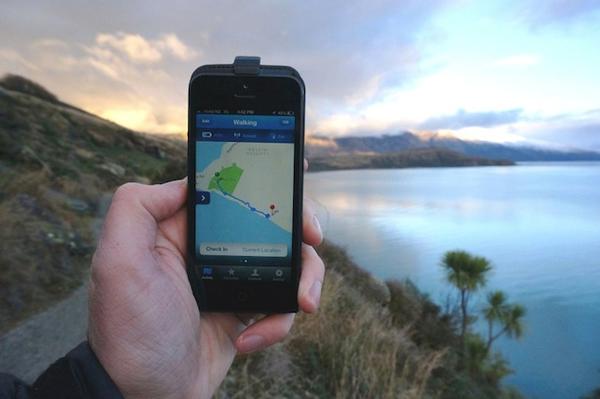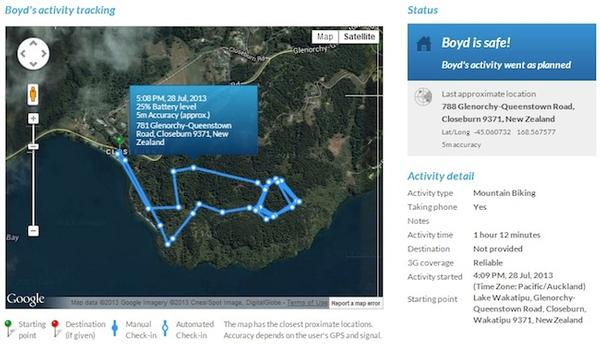New guardian angel App 'Get Home Safe' aims to save lives of Australians
A new company that privately monitors users’ location during an activity or task and raises a pre-set alarm if they don’t ‘’Get Home Safe’ is being launched in Australia today (Monday November 11).
Get Home Safe (GHS), believed to be the first App of its kind in Australasia, is the brainchild of Kiwi entrepreneur Boyd Peacock.
Launched in New Zealand in August, Get Home Safe received extensive international media attention and topped the country’s iPhone App download charts hitting the number one spot on its first day of release.
GHS is simple and easy to use and aimed at people from all walks of life undertaking everyday activities such as children walking home from school alone, women travelling home after a night out and people working unsupervised in remote areas or in the bush.
Australians will be able to download and use the free smartphone App from today.
Once downloaded users register with GHS what they intend on doing, such as walking home after dark or going for a bike ride, and the time they will be ‘home safe’, for example in 15 minutes.
GHS then acts as a ‘guardian angel’ safely recording GPS location data and check-in prompts to privately watch over the user’s movements throughout their chosen activity.
If something unforeseen happens and the user doesn’t stop or extend tracking as planned, an alarm is raised and the information GHS has safely recorded is sent to the person’s pre-selected personal emergency contacts.
As the alarm is sent from the GHS servers not the phone, users don’t need a working phone or coverage for the alarm to be raised, making it a vital safety tool if something unforeseen happens.
“GHS actually calls for help when you can’t, it’s truly amazing and really could save someone’s life,” said Mr Peacock.
“This App has been designed to be so simple, quick, private and free to use. People are using it as they go about their day-to-day business.” said Mr Peacock.
“If you have ever said “I’ll call you when I get there” or “I’ll let you know I’ve made it home”, then Get Home Safe is for you.”
“The App is only part of the Get Home Safe concept. What we have actually created is the automation of checking people are OK.
“GHS is capable of checking every Australian child and teenager gets home safely from school this afternoon and even if every Australian party goer gets home safely tonight,” he said.
“GHS is capable of checking every Australian driver arrives safely at their destination today. And it can do it all again tomorrow.”
“Of course people need a smartphone and the App activated for this to happen, but there are so many people who could benefit from GHS and we’re offering to do all this for free.”
Get Home Safe can also be the perfect complement to journey management plans and ‘phone in/phone’ out procedures used by many Australian companies to check the well-being of their employees when they are travelling long distances or working in remote locations.
Since launch, GHS has had enquiries from a number of large New Zealand organisations who want to make the use of GHS compulsory for staff undertaking work in remote locations or where there is perceived danger.
“Even the best-made plans can encounter the unforeseen. Regular alarms prompt you to check-in, so if you ever did need help the alarm would be raised far quicker and your last location mapped by our servers,” he said.
“Who knows you’ve gone for that run or bike ride? Who knows you’re walking home late at night from the pub or bus stop, or that you’re driving the back road home this time?
“Who knows where your secret fishing spot is? Who knows exactly where you are working this afternoon? Who will know if you don’t get home safe?”
Mr Peacock said the App would also provide the ultimate ‘peace of mind’ for families with teenagers doing after school or weekend activities, especially as so many youngsters now have phones.
“GHS is not your mother, your boss or big brother and it’s certainly not the police. GHS does not judge or ask probing questions”.
“We have created the App so it can be used privately, making it perfect if you are self-conscious about sharing your plans or location, or even if you feel like a bit of a wimp for using a safety App, as long as you check-in on time, no one needs to know you are using it.”
The App was developed by Dunedin-based website and design companies Firebrand and Greengage for Mr Peacock’s company Get Home Safe Limited.
It is free to download from Apple’s App Store at https://itunes.apple.com/app/id654865653 and Google Play Store via https://play.google.com/store/apps/details?id=com.gethomesafe
Within the App users can choose to buy pre-paid text messages for 20 cents each, with a minimum purchase of $US1.99 and use the text alert method. Unused text alerts are credited back to users if they check in on time and email alerts are free.
New Zealand-based Mr Peacock said GHS would also be ‘invaluable’ to those going out on short trips boating, bush walking, fishing, or cycling.
GHS is a compliment to the traditional satellite emergency beacon as “not every emergency or unforeseen event requires activating an expensive official search operation via a beacon.”
Users can opt to send their emergency contacts a pre-trip itinerary to allow them to follow the activity in real time or share ‘home safe’ summaries via email and social media.
NZ Mountain Safety Council CEO Darryl Carpenter said he was “very impressed with the potential and accessibility of Get Home Safe.
“We are working closely with Get Home Safe to ensure it meets the requirements of becoming an approved outdoors intentions provider," said Mr Carpenter.
“GHS will provide a valuable safety service for outdoor enthusiasts and there are clearly possibilities for other activities in everyday life.”
The GHS idea was inspired after Mr Peacock read about a boating accident in New Zealand’s Foveaux Straight in 2012 when a group of fishermen’s boat sank with all their mobile phones and emergency equipment on board.
“I thought to myself, if only someone was monitoring the use and location of a smart phone on board it could have been apparent much earlier that the fishermen had capsized and even where it happened, the alarm could have been raised much earlier,” Mr Peacock said.
“GHS sends alarms independently of mobile phone coverage so if the fishermen had set regular half hour alarms with GHS then the alarm would have been raised as soon as they missed their first check-in and their last known location identified,” he said.
“There have been a number of reported examples lately in Australia where people have been injured in accidents or needed to call for help but haven’t been able to.
“Get Home Safe could have provided the perfect alert system in many of these instances, alerting help sooner rather than later.”
How to use Get Home Safe:
The GHS app is downloaded from Apple or Google app sites, then users set a PIN, input their trip or planned activity and preferred emergency contacts.
Depending on the duration of the activity, users can set an alarm for when they plan to return home or can set regular alarms (say every five minutes for shorter activities or every half hour for longer ones).
Based on GPS location data GHS will privately watch over the user’s movements and remaining battery life throughout the duration of their activity via independent servers.
Before each alarm time is reached several alerts are sent to the user prompting them to check in. If the user doesn’t respond or extend the alarm and it appears things have not gone as planned the GHS servers will send a message to the user’s contacts via email or text message (charges apply).
It informs them the user hasn’t checked in and provides them with the user’s recorded GPS tracking location. It is then up to the user’s emergency contacts to interpret the information and using their best judgement take action (or not) accordingly.
Users can opt to send a pre-trip summary to selected emergency contacts and at any stage during tracking you can activate a panic alarm requesting assistance from your emergency contacts. GHS will send them your location and plans along with your request for assistance.
Users can also set a unique duress PIN that when entered appears to deactivate the GHS app, however a panic alarm is sent off to the emergency contacts requesting assistance.
About Get Home Safe:
Get Home Safe was launched on iPhone in New Zealand on August 5 2013 and spent its first few days in the App store as the most downloaded free app in New Zealand. It has since launched on Android.
Get Home Safe was a finalist in the New Zealand Innovation Awards for innovation in Marketing and Communication.
The app is compatible with devices running iOS 6 & 7 or Android 4.0 and newer.
It is free to download from Apple’s App Store at https://itunes.apple.com/app/id654865653 and Google Play Store via https://play.google.com/store/apps/details?id=com.gethomesafe
The app is free to use with email only alerts. Within the app users can choose to buy pre-paid text messages for 20 cents each, with a minimum purchase of $US1.99 and use the text alert method. Unused text alerts are credited back to users if they check in on time.
The app was developed by Dunedin-based website and design companies Firebrand and Greengage for Mr Peacock’s company Get Home Safe Limited.


